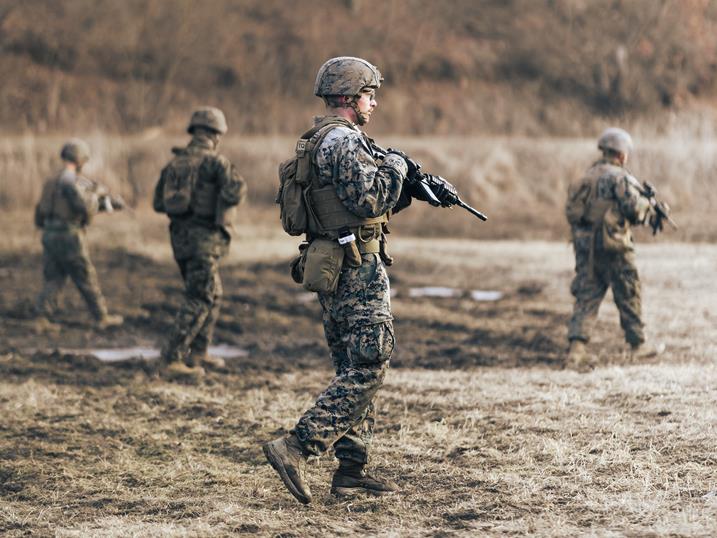BUSHIDO STRIKE 23 CULMINATES
BUSHIDO STRIKE 23 CULMINATES, III MSB SHIFTS TO SUPPORTING OPERATIONS IN THE INDO-PACIFIC
28 FEB 2023 | Story by Staff Sgt. Manuel SerranoPEO Land Systems

U.S. Marine Corps Sgt. Ethan Jara, a native of East Bethel, Minnesota and an ammunition technician with III Marine Expeditionary Force Support Battalion, III Marine Expeditionary Force Information Group, maneuvers his fire team on an Infantry Battle Platoon Course during a live fire range on U.S. Army Garrison Casey, Gyeonggi, South Korea, Feb. 10, 2023. III MSB is conducting Bushido Strike 23, which comprises training events including a Marine Corps Combat Readiness Evaluation in South Korea to validate its mission essential tasks of providing combat service, security and administrative services to III Marine Expeditionary Force. (U.S. Marine Corps photo by. Staff Sgt. Manuel
On Feb. 23, more than 90 Marines and sailors with III Marine Expeditionary Force (MEF) Support Battalion (MSB) concluded a month-long unit training known as Bushido Strike 2023. III MSB enhanced and evaluated their combat readiness at U.S. Army Garrison Camp Casey, South Korea.
“Bushido Strike focuses on training, it builds resiliency, and it helps us to be prepared for war and our ability to deploy and fight now,” said Lt. Col. Richard Wagner, a Tacoma, Washington native and the commanding officer of III MSB.
III MSB completed Bushido Strike 23 with a Marine Corps Combat Readiness Evaluation (MCCRE) that validated its mission essential tasks as they pertain to combat readiness. The focus was to safely conduct training and imbue the Marines and sailors with a greater confidence in their warfighting skills.
“Every Marine is a rifleman,” said Sgt. Maj. Leonel Cuellar, a San Antonio native and the sergeant major of III MSB. “Even though we are not an infantry unit, we still have to perform rifleman skills. It is on us as a command to enable and put conditions in place to set them up for training. That is Bushido Strike.”
III MSB provides and coordinates direct combat service support, security and administrative services to III MEF, 3rd Marine Expeditionary Brigade (MEB) and III MEF Information Group (MIG) to sustain command and control and Marine Air-Ground Task Force (MAGTF) operations.
“I’m biased obviously, but I love these Marines,” said Maj. Kevin Jones, a native of San Antonio and the training site commander. He shared how the MSB Marines do not take these opportunities for granted. Their enthusiasm stimulated productive training.
The Marines and sailors participated in various events including a combat lifesaver course, pistol and rifle ranges, crew-served weapons ranges, live fire tactical vehicle convoys and various professional military education classes. During these evolutions, the Marines and sailors were exposed to new opportunities and they practiced being comfortable with the uncomfortable in the frigid South Korean winter.
“It is realistic training,” said Maj. Nicholas Cormier, a San Antonio native and the operations officer of III MSB. “It is as close as we can get to being able to do our job and increase our proficiency across all MOSs [Military Occupational Specialty]. Everyone is going to get on a weapon system and gain proficiency and knowledge.”
The Infantry Platoon Battle Course (IPBC) was an integral event that allowed the Marines to exercise their leadership capabilities and maneuver a squad through the battlespace, all while demonstrating the skills of a basic rifleman.
“The IPBC was the most important event to me,” said Sgt. Ethan Jara, a native of East Bethel, Minnesota and small arms technician with III MSB. “Understanding how to break down into fire teams as you conduct buddy rushes, maneuver into contact and close with the enemy to destroy them is critical.”
Jara added that to be an effective rifleman, a Marine should understand the fundamentals of weapons handling and learning how to be comfortable with that firearm. Bushido Strike provided the opportunity for everyone to train and learn side by side.
“It is a good way to build a common knowledge with one another and still be held accountable to what a Marine should be doing as well,” said Hospital Corpsman 3rd Class Nora Wold, a native of Plainsfield, Illinois with III MSB. “At the end of the day, the Marine is a rifleman, so a corpsman should be out in the battlefield.”
The Navy-Marine Corps team synergy started as soon as the unit arrived at Camp Casey. The medical team, comprised of a naval medical officer, a hospital corpsman chief, two hospital corpsmen petty officers and a hospital seaman, trained and certified more than 40 Marines in Tactical Combat Casualty Care/Combat Lifesaver Course.
Aside from providing vital lifesaving skills, the sailors were also able to join the Marines throughout the training. The corpsmen qualified on the newly fielded M18 service pistol and fired crew-served weapons. The takeaway for the corpsmen was a better understanding of those lives entrusted to their care.
Most of the Marines that participated in Bushido Strike and the MCCRE will return to Okinawa, Japan following the training to continue to support MIG/MEB/MEF operations.
“MEF Support Battalion Marines and sailors are the unsung heroes of III MEF,” said Wagner. “They understand that their jobs are not glorious, but it is absolutely essential for the MEF command element to focus on warfighting. We hope that this training builds confidence and a solid foundation that reinforces the basic warrior skills: shoot, move, communicate and treat casualties.”